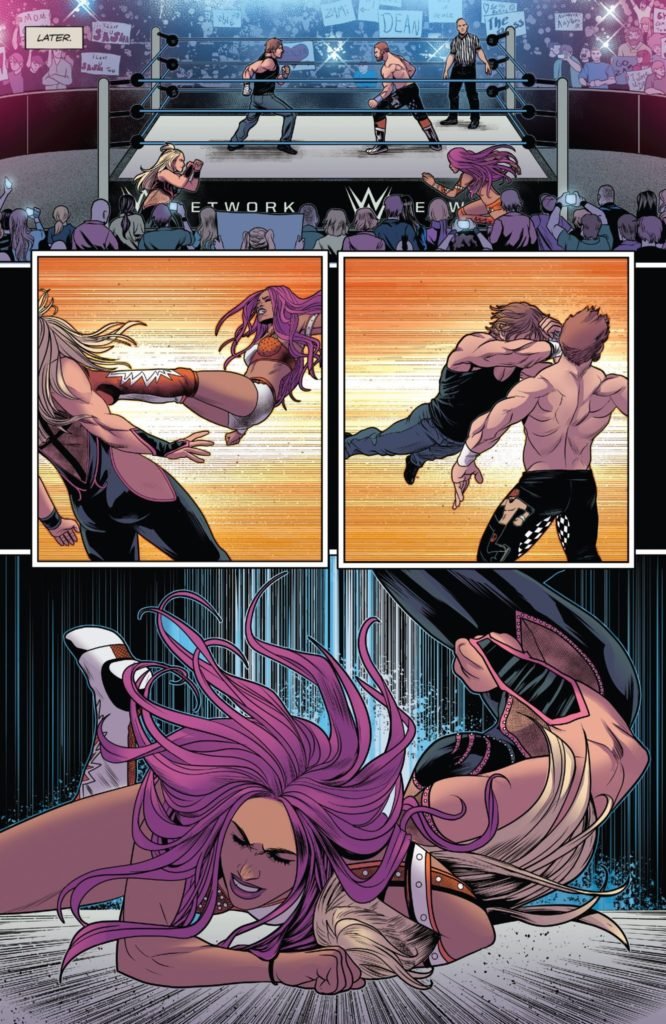WWE #6
BOOM! Studios, June 2017
Writer: Dennis Hopeless
In the professional wrestling industry in the United States, the word “kayfabe” refers to the code or principle in which the wrestlers and employees of a promotion must maintain the illusion of reality even outside of the ring and beyond the camera’s gaze. This means in-ring rivals must keep up appearances and be hostile against each other in the public eye, matches must be treated as genuine, results are never considered as staged or pre-scripted, and so on. It is a tool meant to assist in the suspension of disbelief among fans of the sport.
Kayfabe has been deprioritized in the past few years. The largest mainstream promotor of the events, the World Wrestling Entertainment, has repositioned itself in the industry as “Sports Entertainment”. In addition, the advent of social media has made it that much harder for wrestlers to maintain private lives separate from their in-ring personas.
The comic book series simply titled “WWE” from BOOM! Studios retains the concept of kayfabe. It presents stories in which the wrestlers entirely embrace their in-ring personae even if the stories venture outside of the ring or away from the sports entertainment business. In this title, the results of matches are not predetermined, wrestlers win or lose based on how good they are or whether the enemies cheated, and that most of the time villains are defeated if a good-natured wrestler is determined and focused enough. The never ending battle of good versus evil, manifest in these heavily muscled men and women in their outlandish costumes, is regarded as real.
The story of the sixth issue of this title follows two wrestlers, the Superstar (what the WWE calls male wrestlers) Dean Ambrose and the Diva (what the WWE calls its female wrestlers) Sasha Banks. The latter is struggling with returning to in-ring work after recovering from a leg injury. A slow return to form is compounded by the constant hounding and bullying of her main rival, Charlotte Flair, in and outside of the ring. Dean Ambrose serves as a traveling companion, and eventually informal advisor to Sasha Banks, as he indirectly shows her how to focus and direct her frustrations towards something more productive. Inherent in the plot is a cheesy lesson pertaining to knowing one’s true self, with the end point being Sasha’s success against her no-good rival.
We have no complaints with the quality of writing for this issue. Writer Dennis Hopeless is supremely talented, and appears to be indulging (or, perhaps, slumming) in a fan project. The dialogue is decent, and there is an actual story with a clear direction. But we question its purpose. The main selling point of professional wrestling – the athletics performed within the ring – is minimally addressed and even considered as ancillary to the protagonists’ antics on the road. In fact, even the resolution of Sasha Bank’s rivalry with Charlotte Flair is treated as an afterthought, neatly wrapped up in a couple of pages after the two protagonists have gone through:
A.) eating at a fancy restaurant
B.) dancing in a club
C.) camping out in the woods
D.) spending a day in a carnival
E.) competing in a derby
Even though the issue does not explicitly address whether there’s a romantic relationship between the two protagonists, the comic still reads more like a 1980s romantic comedy film than a story about professional wrestlers. Despite the preservation of “kayfabe,” this particular comic will still fail to engage a wrestling fan as the plot relies more on themes and topics that do not benefit from, nor require, “kayfabe.” This comic is basically only enjoyable as wrestling-inspired fanfiction.
Other reviewers broadly agree with our dour assessment:
a. J.P. Harvey at Comic Crusaders says, “Based on an industry full of over the top costumed characters that spout cliched dialogue and pound the stuffing out of each other on a recurring basis, you’d think that professional wrestling and the comic book medium would be a natural fit. And it just could be, if it were in more capable hands. To cut to the quick, this comic is boring! The story by Dennis Hopeless… has less conflict or characterization than a Road Runner cartoon…”
b. “[T]he creative team build upon Dean Ambrose and Sasha Banks’ story in bold fashion. Unfortunately this does very little to the narrative as a whole, feeling littler more than filler material,” observes John McCubbin at Snap Pow ; and
c. Patrick Ross at Adventures in Poor Taste correctly notes the relationship between the two protagonists “but it feels unearned and pretty out of nowhere. Time will tell if this relationship between the two goes anywhere or if it’s simply a way to intertwine Ambrose’s foibles with Sasha’s Charlotte woes.As far as their chemistry, it teeters romcom trope territory, whether their relationship is meant to be romantic or not (I’m honestly not sure).” Oddly, he rates the book 7.5/10, demonstrating that his reviews have more tumbles and twists than a WWE cage match. Kayfabe, indeed.


